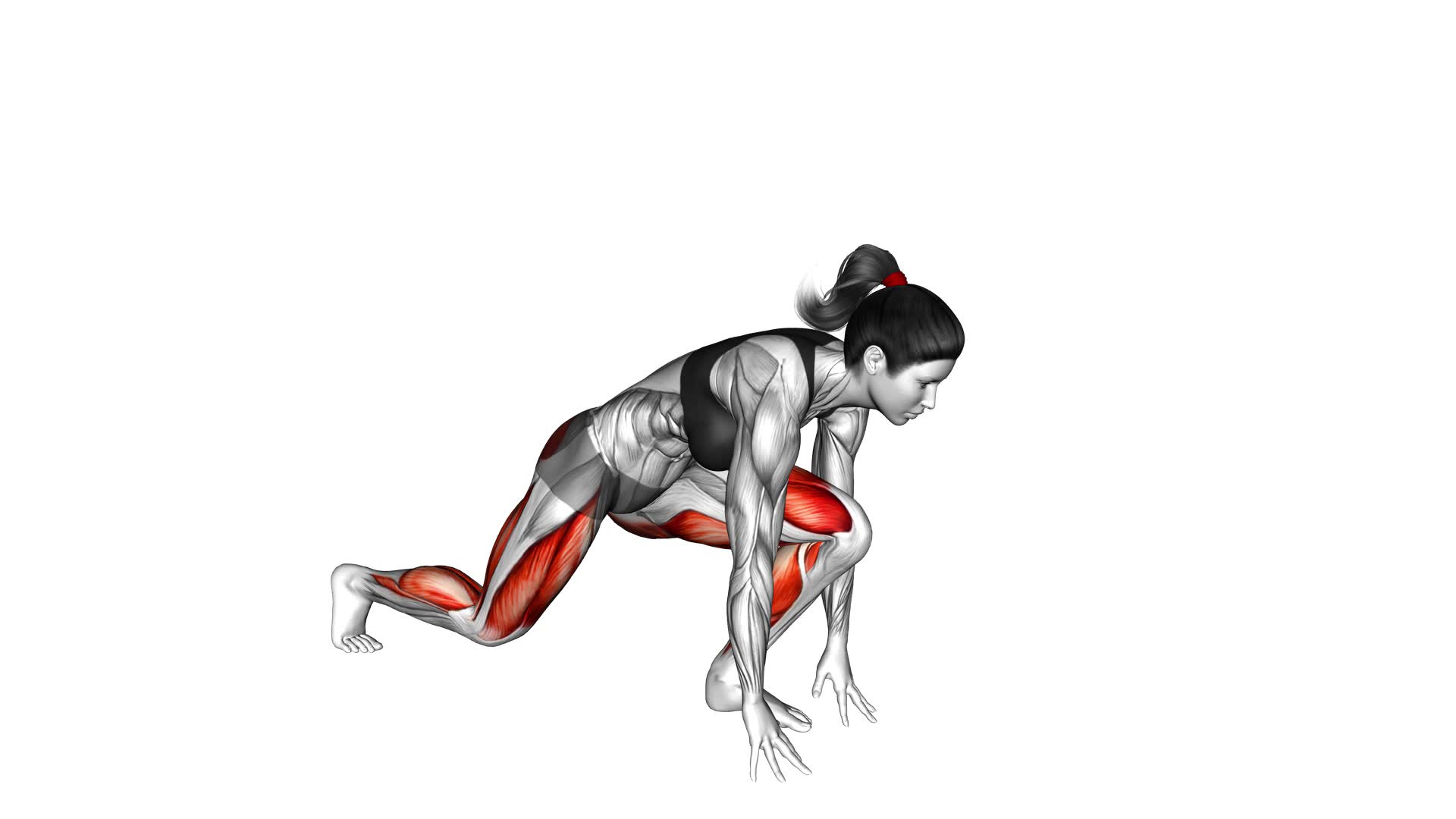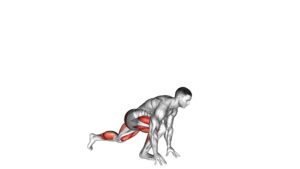Split Sprinter Low Lunge (female) – Video Exercise Guide & Tips

Get ready to tone your legs and boost your fitness with the Split Sprinter Low Lunge. This video exercise guide will show you how to properly perform this dynamic move, targeting your quads, glutes, and hamstrings.
Watch This Exercise Video
Whether you're a beginner or advanced, you'll find modifications to suit your fitness level. Avoid common mistakes and get the most out of your workout with our helpful tips.
Let's get started and feel the burn!
Key Takeaways
- The Split Sprinter Low Lunge increases leg strength and stability.
- It enhances flexibility and mobility in the hips and lower body.
- The exercise improves overall stability and balance.
- The Split Sprinter Low Lunge can be modified for beginners and advanced individuals to cater to different fitness levels and goals.
Benefits of the Split Sprinter Low Lunge
To maximize the effectiveness of your workout, incorporate the Split Sprinter Low Lunge into your routine and experience increased flexibility and strength.
This exercise is known for its ability to improve leg strength and stability while also enhancing flexibility and mobility.
The Split Sprinter Low Lunge specifically targets the muscles in your legs, including the quadriceps, hamstrings, and glutes. By performing this exercise regularly, you can expect to see significant improvements in your leg strength, allowing you to perform other exercises with greater ease and efficiency.
Additionally, the Split Sprinter Low Lunge requires a wide range of motion, which helps to increase flexibility and mobility in your hips and lower body. This can be especially beneficial for athletes or individuals who participate in activities that require dynamic movements.
The combination of increased leg strength and improved flexibility can also contribute to better overall stability. This is particularly important for activities that involve balance, such as yoga or sports that require quick changes in direction.
Incorporating the Split Sprinter Low Lunge into your workout routine can provide numerous benefits, including increased flexibility and mobility, as well as improved leg strength and stability. Whether you're an athlete looking to enhance your performance or simply want to improve your overall fitness, this exercise is worth incorporating into your routine.
Proper Form and Technique
To ensure proper form and technique during the Split Sprinter Low Lunge, focus on maintaining a stable and balanced position throughout the exercise. This will help you improve your balance and activate the correct muscles.
Start by standing with your feet hip-width apart, then take a big step forward with your right foot, keeping your weight evenly distributed between both legs. Bend your right knee and lower your body until your right thigh is parallel to the ground, making sure your knee doesn't extend past your toes.
Your left leg should be extended behind you, with your left knee slightly bent and your left foot resting on the ball of your foot. Engage your core and keep your chest lifted throughout the movement.
To enhance muscle activation, push through your right heel as you return to the starting position.
Now that you understand the proper form and technique of the Split Sprinter Low Lunge, let's explore some modifications for beginners and advanced individuals.
Modifications for Beginners and Advanced
For beginners and advanced individuals, modify the Split Sprinter Low Lunge to suit your fitness level and goals. Here are some modifications you can make:
- Beginner modifications:
- Start with a shorter lunge: If you're new to lunges or have limited flexibility, you can start with a shorter lunge position. This will allow you to focus on your form and gradually increase the depth of the lunge as you become more comfortable.
- Use a support: If you have trouble balancing or feel unstable during the lunge, you can use a chair, wall, or any other stable surface as support. This will help you maintain your balance and prevent any potential injuries.
- Reduce the speed: If you find it challenging to perform the lunge at a fast pace, slow down and focus on your technique. It's better to perform the exercise correctly at a slower pace than to rush through it with poor form.
- Advanced modifications:
- Increase the range of motion: If you're looking to challenge yourself and increase the difficulty of the exercise, you can deepen the lunge by taking a larger step forward. This will engage your muscles more and intensify the workout.
- Add weights: To further enhance the strength-building aspect of the exercise, you can hold dumbbells or kettlebells in your hands while performing the lunge. This will increase the resistance and make the exercise more demanding.
- Incorporate jumps: For a cardiovascular boost and an extra challenge, you can add a jump to the lunge. As you step forward into the lunge position, explosively push off the ground and switch legs mid-air, landing in a lunge position with the opposite leg forward.
Remember to listen to your body and progress at your own pace. With these modifications, you can customize the Split Sprinter Low Lunge to meet your specific needs and fitness level.
Common Mistakes to Avoid
Avoid these common mistakes when performing the Split Sprinter Low Lunge to ensure proper form and maximize the effectiveness of the exercise. By avoiding these mistakes, you can also reduce the risk of injuries and improve your balance.
First, make sure to maintain proper alignment throughout the exercise. Keep your front knee directly above your ankle and avoid letting it extend too far past your toes. This will help prevent strain on your knee joint and ensure that you're engaging the right muscles.
Another common mistake isn't engaging your core. Your core muscles play a crucial role in maintaining balance and stability during the lunge. So, remember to activate your core by pulling your belly button towards your spine and keeping your torso upright.
Furthermore, avoid rushing through the movement. Take your time to lower into the lunge and focus on the quality of the movement rather than the quantity. This will help you maintain control and stability throughout the exercise.
Finally, be mindful of your rear foot placement. Make sure your toes are pointing forward and that your heel is lifted off the ground. This will help you maintain balance and prevent unnecessary strain on your ankle.
By avoiding these common mistakes, you can perform the Split Sprinter Low Lunge with proper form, reduce the risk of injuries, and improve your balance.
Now, let's move on to some tips for getting the most out of your workout.
Tips for Getting the Most Out of Your Workout
Maintain proper form and maximize the effectiveness of the Split Sprinter Low Lunge by implementing these tips to get the most out of your workout.
- Focus on proper alignment: When performing the Split Sprinter Low Lunge, it's crucial to pay attention to your body's alignment. Ensure that your front knee is directly above your ankle, and your back knee is hovering just above the ground. This will help target the correct muscles and prevent strain or injury.
- Engage your core: To maximize the results of this exercise, engage your core throughout the movement. Tightening your abdominal muscles won't only help stabilize your body but also add an extra challenge to your workout. By incorporating your core, you'll be working multiple muscle groups simultaneously, leading to greater workout efficiency.
- Control your movements: It's essential to maintain control throughout the entire exercise. Avoid rushing through the lunge and focus on the quality of your movements. By moving slowly and deliberately, you can ensure that you're properly engaging your muscles and maximizing your results.
Frequently Asked Questions
How Many Calories Does the Split Sprinter Low Lunge Burn?
The split sprinter low lunge is a calorie burning exercise that can help you shed those extra pounds. It targets multiple muscle groups, including your glutes, quads, and hamstrings, making it an effective full-body workout.
In addition to its calorie burning benefits, the split sprinter low lunge also improves your balance, flexibility, and core strength.
Can the Split Sprinter Low Lunge Help Improve Flexibility?
The split sprinter low lunge is a great exercise for improving hip mobility and flexibility. By regularly incorporating this move into your workout routine, you can experience the benefits of increased range of motion and improved flexibility in your hips.
This exercise specifically targets the hip flexors and quadriceps, helping to stretch and strengthen these muscles. Whether you're an athlete or just looking to enhance your overall flexibility, the split sprinter low lunge is a valuable addition to any fitness regimen.
Is It Necessary to Warm up Before Performing the Split Sprinter Low Lunge?
Before performing the split sprinter low lunge, it's important to warm up. Warming up helps increase blood flow to your muscles and prepares your body for exercise, reducing the risk of injury.
It also helps improve flexibility and range of motion. If you're looking for alternative exercises, you can try lunges, squats, or other lower body exercises that target similar muscle groups.
Remember to always listen to your body and modify exercises as needed.
Can the Split Sprinter Low Lunge Be Done With Weights or Resistance Bands for Added Difficulty?
Using dumbbells for split sprinter low lunge can add difficulty and intensity to your workout. The added weight challenges your muscles and helps to build strength and endurance.
On the other hand, incorporating resistance bands into the split sprinter low lunge can provide additional benefits. The bands create tension, targeting different muscle groups and improving stability and balance.
Whether you choose dumbbells or resistance bands, both options can enhance the effectiveness of the split sprinter low lunge.
How Often Should the Split Sprinter Low Lunge Be Included in a Workout Routine for Maximum Results?
To get maximum results, you should include the split sprinter low lunge in your workout routine regularly. The frequency of this exercise will depend on your fitness goals and the intensity of your workouts.
Aim to incorporate the split sprinter low lunge at least 2-3 times per week. Remember, you can always vary the exercise by adding weights or resistance bands to increase the difficulty level and challenge your muscles even more.
Conclusion
Incorporating the split sprinter low lunge into your workout routine can provide numerous benefits, including improved lower body strength and flexibility.
By maintaining proper form and technique, you can maximize the effectiveness of this exercise.
Beginners and advanced individuals can easily modify the movement to suit their fitness level.
Remember to avoid common mistakes and follow these tips to get the most out of your workout.
Start incorporating the split sprinter low lunge into your routine today for a stronger and more flexible lower body.

Author
Years ago, the spark of my life’s passion ignited in my mind the moment I stepped into the local gym for the first time. The inaugural bead of perspiration, the initial endeavor, the very first surge of endorphins, and a sense of pride that washed over me post-workout marked the beginning of my deep-seated interest in strength sports, fitness, and sports nutrition. This very curiosity blossomed rapidly into a profound fascination, propelling me to earn a Master’s degree in Physical Education from the Academy of Physical Education in Krakow, followed by a Sports Manager diploma from the Jagiellonian University. My journey of growth led me to gain more specialized qualifications, such as being a certified personal trainer with a focus on sports dietetics, a lifeguard, and an instructor for wellness and corrective gymnastics. Theoretical knowledge paired seamlessly with practical experience, reinforcing my belief that the transformation of individuals under my guidance was also a reflection of my personal growth. This belief holds true even today. Each day, I strive to push the boundaries and explore new realms. These realms gently elevate me to greater heights. The unique combination of passion for my field and the continuous quest for growth fuels my drive to break new ground.







